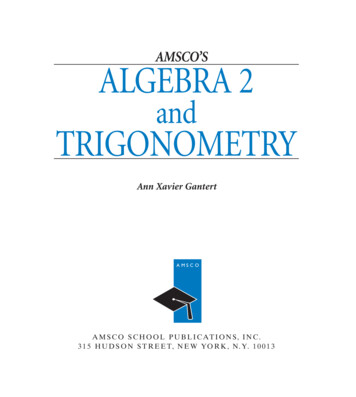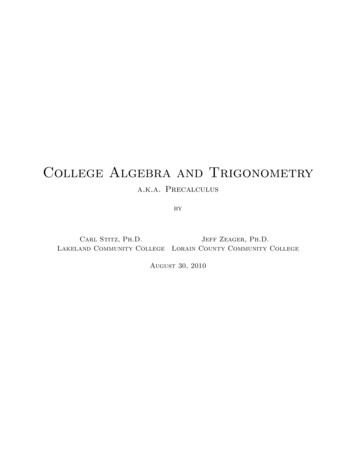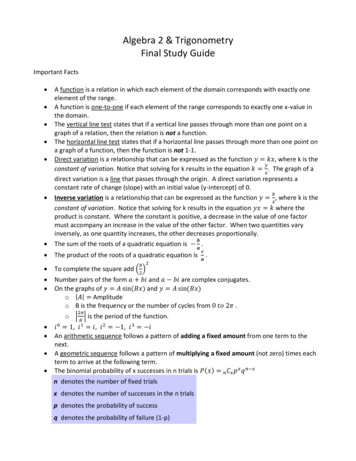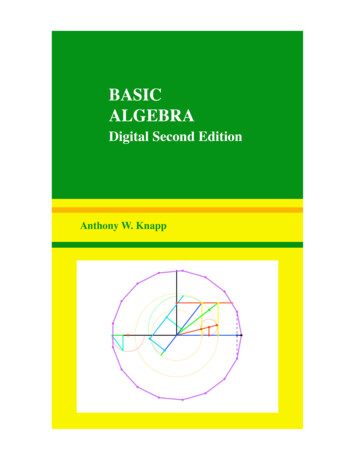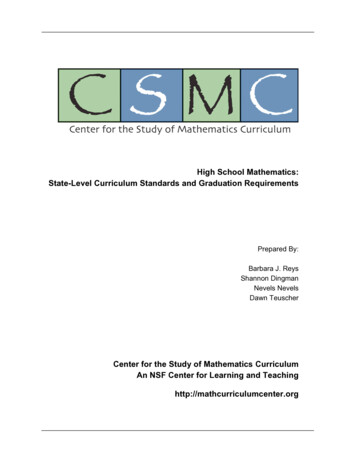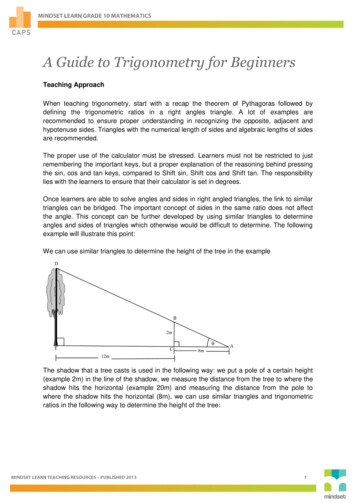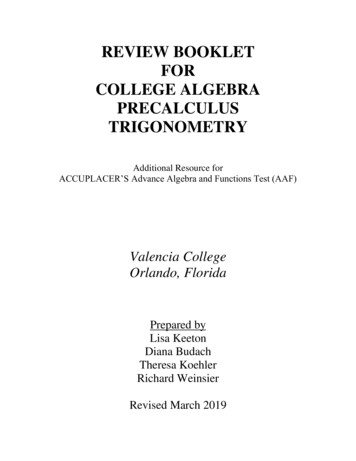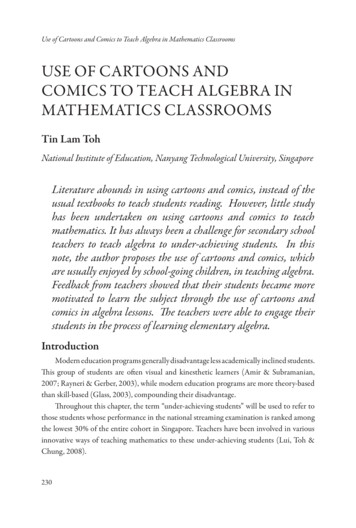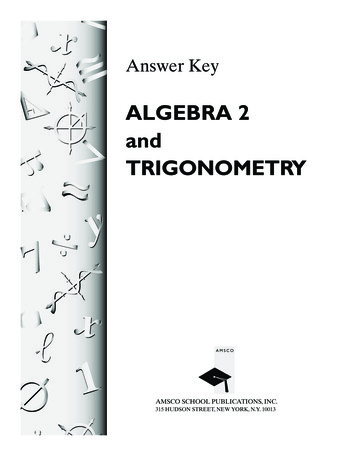
Transcription
14580AK FM.pgs3/26/0912:07 PMPage iAnswer KeyALGEBRA 2andTRIGONOMETRYAMSCOAMSCO SCHOOL PUBLICATIONS, INC.315 HUDSON STREET, NEW YORK, N.Y. 10013
14580AK FM.pgs3/26/0912:07 PMPage iiPlease visit our Web site at: www.amscopub.comWhen ordering this book, please specify: N 159 K orANSWER KEY/ALGEBRA 2 AND TRIGONOMETRYCopyright 2009 by Amsco School Publications, Inc.No part of this Answer Key may be reproduced in any form without written permission from thepublisher except by those teachers using the AMSCO textbook ALGEBRA 2 ANDTRIGONOMETRY, who may reproduce or adapt portions of this key in limited quantities forclassroom use only.Printed in the United States of America1 2 3 4 5 6 7 8 9 1014 13 12 11 10 09
14580FM.pgs3/26/0912:11 PMPage ivContentsAnswer KeysFor Enrichment Activities246For Extended Tasks255For Suggested Test Items261For SAT Preparation Exercises269For Textbook ExercisesivChapter 1271Chapter 2274Chapter 3277Chapter 4282Chapter 5291Chapter 6299Chapter 7303Chapter 8308Chapter 9312Chapter 10319Chapter 11324Chapter 12334Chapter 13343Chapter 14345Chapter 15349Chapter 16359
14580AKEA.pgs3/26/0912:07 PMPage 246Answers for Enrichment ExercisesEnrichment Activity 1-5:On the Ins and Outs7.1. a. 110 2 108 5 2b. 380 2 378 5 2c.(30 1 1)(30 1 2) 2 f30(30 1 3)g5 302 1 3(30) 1 2 2 302 2 3(30)52d.(x 1 1)(x 1 2) 2 x(x 1 3)5 x2 1 3x 1 2 2 x2 2 3x522. The products differ by 2.3. a. 130 2 112 5 18b. 598 2 580 5 18c. 11,128 2 11,110 5 18d.(x 1 3)(x 1 6) 2 x(x 1 9)5 x2 1 9x 1 18 2 x2 2 9x5 184. The products differ by 18.5. The products differ by 32.6. a.(x 1 2)(x 1 4) 2 x(x 1 6)5 x2 1 6x 1 8 2 x2 2 6x58b.(x 1 5)(x 1 10) 2 x(x 1 15)5 x2 1 15x 1 50 2 x2 2 15x5 50c.(x 1 6)(x 1 2(6)) 2 x(x 1 3(6))5 x2 1 3(6x) 1 2(62) 2 x2 2 3(6x)5 2(62)5 72d.(x 1 k)(x 1 2k) 2 x(x 1 3k)5 x2 1 3kx 1 2k2 2 x2 1 3kx5 2k27. If the numbers increase by any real number k,then the difference of the product is 2k2.8. 98.9.10.11.12.13.Enrichment Activity 2-5: InvestigatingRatios and Growth Rate in LeavesStudents answers will all differ as they havedifferent size leaves. If the length to width ratios arevery similar, students should conclude that the rate ofgrowth in their tree or bush is constant. If the lengthto width ratios vary a lot, they should conclude thatthe growth rate for their tree or bush is not constant.Students should be assessed on the followingcharacteristics:a. the accuracy of their measurementb. the construction of their data table and scatterplotc. the accuracy of their computations with thecalculatord. their knowledge of ratio and averagee. the neatness of their workf. their ability to follow directionsg. how well they work with others if the activity isdone as a grouph. their ability to reach a conclusionEnrichment Activity 1-6: Factoring theSum and Difference of Two Cubes1.2.3.4.5.6.a3 2 b35 a3 2 a2b 1 a2b 2 ab2 1 ab2 2 b35 a2(a 2 b) 1 ab(a 2 b) 1 b2(a 2 b)5 (a 2 b)(a2 1 ab 1 b2)(2x 1 y)(4x2 2 2xy 1 y2)(x 2 2y)(x2 1 2xy 1 4y2)(5 2 3d)(25 1 15d 1 9d2)(4x 1 3y)(16x2 2 12xy 1 9y2)a4 2 b45 a4 2 a3b 1 a3b 2 a2b2 1 a2b2 2 ab31 ab3 2 b45 a3(a 2 b) 1 a2b(a 2 b) 1 ab2 (a 2 b)1 b3(a 2 b)5 (a 2 b)(a3 1 a2b 1 ab2 1 3)5 (a 2 b) fa2(a 1 b) 1 b2(a 1 b)g5 (a 2 b)(a 1 b)(a2 1 b2)a4 2 b4 5 (a2 2 b2)(a2 1 b2)5 (a 2 b)(a 1 b)(a2 1 b2)(x 2 2)(x2 1 2x 1 4)(x 1 4)(x2 2 4x 1 16)(x 2 4)(x2 1 4x 1 16)(x 1 5)(x2 2 5x 1 25)(x 2 2y)(x2 1 2xy 1 4y2)a3 1 b35 a3 1 a2b 2 a2b 2 ab2 1 ab2 1 b35 a2(a 1 b) 2 ab(a 1 b) 1 b2(a 1 b)5 (a 1 b)(a2 2 ab 1 b2)Enrichment Activity 3-2:A Square-Root Algorithm1. 575. 2.62462. 726. 4.13. 917. 5.94. 398. 9.4
14580AKEA.pgs3/26/0912:07 PMPage 247Enrichment Activity 3-5:A Radical SequenceEnrichment Activity 5-6A:Complex Number Operations,Vectors,and Transformations1 25 3 12 !51. 1 12 !5 1 1 5 1 1 !521. a.2. 4 1 22 !5 5 2 1 !5yiB3. 7 1 23 !5, 11 12 5 !54. The sequence has a common ratio, r.A, E5. 1 12 !521 55 6 1 22 !5 5 3 12 !56. Q 1 12 !5 R 5 1 1 2 !52xO1 57. Q 3 12 !5 RQ 1 12 !5 R 5 3 1 4 !54C5 8 1 44 !5 5 2 1 !5D7 1 3 !558. A2 1 !5B Q 1 12 !5 R 5 1 1 3 !52 1 2 52B 5 23 1 5iC 5 25 2 3iD 5 3 2 5iE 5 5 1 3i 5 Ab. F 5 23 1 5i 5 Bc. Answers will vary: multiplication by i isequivalent to a counterclockwise rotation of90 about the origin. Multiplication by i2 (or21) is equivalent to a rotation of 180 .Multiplication by i3 (or 2i) is equivalent to acounterclockwise rotation of 270 about theorigin. Multiplication by i4 (or 1) is theidentity transformation.d. Answers will vary:Point symmetry in the originRotational symmetry of 90 (as well as 180 and 270 ) about the origin11 1 5 !59. Q 7 1 23 !5 RQ 1 12 !5 R 5 74 1 104!5 1 154 5210. 1.618, the golden ratioEnrichment Activity 4-5:The Method of Finite Differences1.2.3.4.f(x) 5 x2 2 3x 1 8f(x) 5 2x2 1 5x 2 3f(x) 5 3x2 2 4x 2 15f(x) 5 x3 2 2x2 1 5x 2 3Enrichment Activity 4-7:The Difference Quotientg1. a. 2x 1 hb. 2x2. a. x3 1 3hx2 1 3h2x 1 h3b. 3x2 1 3hx 1 h2c. 3x23. a. x4 1 4hx3 1 6h2x2 1 4h3x 1 h4b. 4x3 1 6hx2 1 4h2x 1 h3c. 4x34. a. x5 1 5hx4 1 10h2x3 1 10h3x2 1 5h4x 1 h5b. 5x4 1 10hx3 1 10h2x2 1 5h3x 1 h4c. 5x45. a. 2x3x24x35x4b. Possible answer: The value of the differencequotient when h 5 0 for f(x) 5 xn is nxn21.6. a. 6x5b. 9x8c. nxn21gLine symmetry through AOC, through BOC2. a–c.Hyi30G2010FA210OED247BC10x
14580AKEA.pgs3/26/09b. B 5 4 2 2iD 5 24 2 8iF 5 216 1 8iH 5 16 1 32i3. a–b.12:07 PMPage 2485.C 5 2 2 6iE 5 212 2 4iG 5 28 1 24iyiADCOyixBIa–b. B 5 2 2 3i, C 5 4, D 5 13c. C 5 (2 1 3i) 1 (2 2 3i) 5 4D 5 (2 1 3i)(2 2 3i) 5 22 1 32 5 13d. Both C and D.C 5 (a 1 bi) 1 (a 2 bi) 5 2aD 5 (a 1 bi)(a 2 bi) 5 a2 1 b2e. P 1 Q 5 PQ2a 5 a2 1 b20 5 a2 2 2a 1 b2a 5 1 6 "1 2 b2Since a and b are real numbers, 1 2 b2 0 or1 b2.Thus, P 1 Q 5 PQ when (a, b) 5 (1, 1) or(1, 21).BCADHxOEEnrichment Activity 5-6B: QuaternionsF1. a. 4 1 6i 1 2j 1 3k;4(1, 0, 0, 0) 1 6(0, 1, 0, 0) 1 2(0, 0, 1, 0)1 3(0, 0, 0, 1)b. 27 1 5j 1 8k;27(1, 0, 0, 0) 1 5(0, 0, 1, 0) 1 8(0, 0, 0, 1)c. 6j 1 9k;6(0, 0, 1, 0) 1 9(0, 0, 0, 1)d. 23; 23(1, 0, 0, 0)2. a. (8, 0, 2, 3)b. (0, 4, 7, 21)c. (8, 0, 1, 0)d. (0, 26, 0, 2)3. a. (16, 4, 6, 6)b. (27, 4, 12, 7)c. (1, 0, 0, 0)d. (8, 0, 7, 9)4. a. 26jb. 210ic. 24kd. 221e. 21f. 2kg. kh. j5. 263 1 37i 1 27j 1 9k6. 2a, a real number8. a. 6 2 7i 2 2j 1 k; 90b. 3 2 5j 2 2k; 38c. 28i 2 3j; 73d. 25i 1 9j 2 4k; 1228. 6 solutions; 6i, 6j, 6kGB 5 2iC 5 22 1 2iD 5 24E 5 24 2 4iF 5 28iG 5 8 2 8iH 5 16I 5 16 1 16ic. (1) H, P, X(2) D, L, T(3) B, F, J, N, R, V, Z4. Case 1: Multiplication by 0 1 0i is not atransformation of the plane because every pointmaps to 0, a single point.Case 2: If a 0 but b 5 0, then multiplication bya, is a dilation of a. A dilation of a is a specialcase of spiral similarity where no rotation occurs.Case 3: If a 5 0 but b 0, then multiplication bybi, is a composition, in either order, of a dilationof b and a counterclockwise rotation 90 . Again,this is a special case of a spiral similarity, but alimiting one. (For example, see the result ofmultiplying by i in Exercise 1).Case 4: If a 0 and b 0, the transformation isthe sum of the two images shown in Cases 2 and3. This is a true spiral similarity.Enrichment Activity 6-2:Arithmetic SequencesA true spiral similarity occurs when a point ismultiplied by a 1 bi where a 0 and b 0.1–10. Answers will vary.11. Answers will vary.12. Possible answer: A 5 52, 4, 5, 76 B 5 51, 3, 6, 86248
14580AKEA.pgs3/26/0912:07 PMPage 249Enrichment Activity 7-3:Factoring Expressions with Rationaland Negative Exponents12. x3 (1 2 x)34. x x2 16.47. x 1 15 1 xx29.2(x 2 3)x5111. (x2 1 3) 21113. (x4 1 5)(x5 2 1)1115. (4b2 2 1)(2b2 1 1)7. 24 11. 1.1791(3) 1 min or 60hrb. (1) p6 radians/hr(2) 2p radians/hr(3) 120p radians/hrc. (1) p in./hr(2) 16p in./hr(3) 1,200p in./hr2. a. (1) 2p radians/dayp(2) 12radians/hr5(x2 2 2)x16. 47 10. 34 1. a. (1) 12 hr(2) 60 min or 1 hr2 1 w5w1228. 1 2 3c9 1 cc510.5. 42 9. 43 Enrichment Activity 10-1:Angular Speed and Linear Speed11. y2 (y2 1 1)3. 1 13 xx525. 1 2b b34. 1.6548. 41 112. (x5 1 5)(x5 2 1)1114. (2y7 1 3)(y7 2 1)1116. (5x6 2 3)(3x6 2 1)Enrichment Activity 8-5: Finding eb. (1) 12,800p km/day(2) 1,700 km/hrc. 0 km/any time unit. There is no rotation onthe North Pole because it lies on the axis ofrotation.p3. a. 3 radians/hr2. 2.7182818233. Yes4. Answers will vary.Enrichment Activity 8-6:State Population GrowthAnswers will vary by state and with reference used.Sample answers are shown for New York.Population in 1960: 16,782,304Population in 2000: 18,976,4571. 2,194,1532. About 13.1%3. About 54,8544. y 5 54,854x 1 16,782,304 where x is the numberof years since 19605. a. 19,525,004b. 20,347,814c. 24,461,8646. a. 18,976,457 5 16,782,304e40rb. About 0.31%7. a. 19,595,991b. 20,528,722c. 25,902,1258. Possible answer: The exponential model predictslarger populations than the linear model.9. About 224 years10. About 6.9%b. 2,400p km/hr (use r 5 6,400 km 1 800 km)4. a. 240p radians/minb. (1) 3,360p in./min(2) 280p ft/minc. Yes, 280p ft/min 879.6 ft/mind. 10 mi/hr5. a. (1) 480p rad/min(2) 8p rad/secb. (1) 1,400p in./min(2) 24p in./sec6. a. 24p rad/minb. 360p ft/minc. 1,131 ftEnrichment Activity 10-2:The Angle Between Two LinesEnrichment Activity 9-7:Reflection and Refraction1. a. 98 or 1.1252. a. 145 or 2.8b. 48 c. 4p15b. 70 c. 7p83. a. 1b. 45 c. p44. a. 31 or 0.3b. 18 pc. 1079b. 38 c. 19p905. a.or 0.76. a. 82 1. 35 2. 17 3. a. 123,917 mi/sb. 127,572 mi/sc. 139,535 mi/s249b. 98
14580AKEA.pgs3/26/0912:07 PMPage 250Enrichment Activity 11-3: Graphing Combined Functionsx0p6p4p3p22p33p45p6psin x 1 cos x11.371.421.3710.37020.3721sin x 2 cos psin x 1 cos x21.3721.4221.372120.3700.371sin x 2 cos x0.37020.372121.3721.4221.3711. See p311p62p–1b. 21.42; 5p43. a. 1.42; p44. See above5.yc. 2p1xp6p3p22p35p62p–16. a. 1.42; 3p47.p 3p2, 2 ,b. 21.42; 7p410. a.c. 2p2p8.b. sin x and sin (x 1 p) have opposite values thatadd to 0 at all values of x.c. Graph9. a. Max value 1.3 at 1.047 radiansb. Min value 21.3 at 5.236 radiansc. 2p250
14580AKEA.pgs3/26/0912:07 PMPage 251Enrichment Activity 11-4:Polar Coordinates1.Q 32, 3 !32 RPart II6.2. (0, 2)3. A22!2, 2 !2B14. Q !32 , 22 R5. (0, 21)6. (5, 0)11.13.A 3 !2,A 5,p2Bp4B10.A 4 !2,r 5 2(1 1 sin u)7p4 Br 5 2(1 2 sin u)yy12. (4, p)A 6, p3 B14.A 4, 5p6 Bxx416. r 5 2 cos u 13 sin u15. r 5 ar 5 2(1 1 cos u)Enrichment Activity 11-8:Graphing Polar EquationsPart I1.xx38. Q23 !32 , 22 R7. (0, 22)9.yy7. Each graph is a cardiod (heart) of the same size.Sine graphs are up or down with respect to they-axis and cosine graphs are right or left withrespect to the y-axis.8. Sine graphs are symmetric with respect to they-axis. Cosine graphs are symmetric with respectto the x-axis.9. Enlarging a enlarges the size of the cardiod.Part III10.yyyyxxr 5 2 sin 2ur 5 2 sin 3ur 5 2(1 2 cos u)yyxxxxr 5 0.2ur 5 2 cos 5ur 5 20.2ur 5 2 cos 4u11. When a . 0, the spiral opens right; when a , 0,the spiral opens left.2. Enlarging a enlarges the size of the petals.If b is odd, the graph has b petals.If b is even, the graph has 2b petals.3. See the answer to Exercise 2.4. For b odd, graphs involving the sine aresymmetric with respect to the y-axis and graphsinvolving the cosine are symmetric with respectto the x-axis.For b even, both sine and cosine graphs aresymmetric with respect to the x-axis, the y-axis,the origin.5. See the answer to Exercise 2.Enrichment Activity 12-8:Forming j4. e8. n12. oBonus:2511. 2 !332. !323. 24. 2125. !36. !337. !348. !3
14580AKEA.pgs9. 2 !3213. 123/26/0912:07 PMPage 25210. 111. 4314. 16315. 4 !35. s 2 b 5 a 1 2b 1 c 2 b5 a 1 b 22 2b 1 c12. 125 c 1 a2 2 b6. s 2 a 5 a 1 2b 1 c 2 a5 a 2 2a 21 b 1 cEnrichment Activity 13-4:Solving Trigonometric Inequalities3p1. p4 # x , p2 or 5p4 #x , 22. p2 , x , 3p25 c 2 a2 1 b2 c 1 a 2 b c 2 a 1 b?7. 1 2 cos C 5 ab2225 ab (s 2 b)(s 2 a)3. p2 # x # 3p24. p6 , x , p or 7p6 , x , 2p5. a. p4 , 5p4b. Graph y 5 sin x and y 5 cos x and identifyintervals where the graph of sin x is below thegraph of cos x. The solution is 0 # x , p4 or5p4 , x , 2p.8. (1 1 cos C)(1 2 cos C)25 A abB s(s 2 a)(s 2 b)(s 2 c)221 2 cos2 C 5 A abB s(s 2 a)(s 2 b)(s 2 c)22sin2 C 5 A abB s(s 2 a)(s 2 b)(s 2 c)22sin C 5 ab!s(s 2 a)(s 2 b)(s 2 c)(Reject negative root since the sine of any angleof any triangle is always positive.)c. p4 # x # 5p46.7.8.# x # 7p47p11p, x , 5p6 or 6 , x , 60 , x # p4 or p2 , x # 3p4 or p7por 3p,x#24p4p69. Area 5 12ab sin C25 12ab ? ab!s(s 2 a)(s 2 b)(s 2 c), x # 5p45 !s(s 2 a)(s 2 b)(s 2 c)Enrichment Activity 14-4:Heron’s Formula2210. a. Area 5 12 (5)(12) 5 30b. Area 5 !15(15 2 5)(15 2 12)(15 2 13)2a 1 b 2 c1. 1 1 cos C 5 2ab2ab 12ab21 b2 2 c25 a 1 2ab2ab5555 !15(10)(3)(2) 5 !900 5 3011. a. Area 5 12 (12)(21) 5 126(a 1 b) 2 2 c22abf (a 1 b) 1 cg ? f (a 1 b) 2 cg2ab2 a 1 b 1 c a 1 b 2 c?22abb. Area 5 !27(14)(7)(6) 5 !15,876 5 12612. a. Area 5 12 (4) Q 4 !32 R 5 4 !3b. Area 5 12 (4)(4) sin 608 5 4!32. s 2 c 5 a 1 2b 1 c 2 c5 a 1 b 12 c 2 2cc. Area 5 !6(2)(2)(2) 5 !48 5 4!313. a.5 a 1 2b 2 c2 a 1 b 1 c a 1 b 2 c?3. 1 1 cos C 5 ab225 60!3 m2b. Area 5 !30(30 2 12)(30 2 20)(30 2 28)25 abs(s 2 c)4. 1 2 cos C 55555/C 5 1208Area 5 12 (12)(20) sin 12085 !30(18)(10)(2) 5 !10,8002aba2 1 b2 2 c22ab 22abc2 2 (a2 2 2ab 1 b2)2abc2 2 (a 2 b) 22abfc 1 (a 2 b)g ? fc 2 (a 2 b)g2ab2 c 1 a 2 b c 2 a 1 b?22ab ?5 60 !3 m2Enrichment Activity 14-7:The Law of Tangents351. 210252tan 12 (A 2 B)tan 12 (A 1 B)
14580AKEA.pgs3/26/0912:07 PMPage 2532. 100 3. tan12 (A2 B) 532106. 0.92137. The value from step 6 is very close to thecalculator value of 0.9215.8. 2x 5 12.25, 2y 5 18.25sx 5 10.4983, sy 5 15.6365tan 508 20.3584. A 2 B 5 239.39585. A 1 B 5 100, A 2 B 5 39.395 A 5 69.7 , B 5 30.3 6.csin 80826sin 69.7826 sin 808sin 69.785c5/A 5 69.78/B 5 30.38/C 5 8088. Find c using the Law of Cosines. Then use theLaw of Sines to find A or B.9. a. 90 b. 17c. tan 12 (A 2 B) 5 17xi 2 2xsxyi 2 .2223.757r 5 0.8518A 2 B 5 44.8Enrichment Activity 16-3:Chi-Square (x2) Test for Goodness of Fitd. /A 5 67.48/B 5 22.686csin 908 5 sin 67.48Problem 11.6c 5 sin 67.48c 5 6.5e. 62 1 2.52 5 42.25!42.25 5 6.56f. tan A 5 2.56/A 5 tan21 A 2.5B5 67.4810. A 5 36.6 B 5 23.4 c 5 30.512. 12.75AmountExpectedFrequency(Observed 2 Expected) 2Expected 0.502002.88 1.001500.96 2.001003.24 3.00505.78tan B 5 2.56/B 5 tan21 A 2.56 B5 22.682. 12.863. Yes; 12.86 . 7.81Problem 21.Enrichment Activity 15-8:Calculating the Correlation Coefficient1. 3.55.xixi 2 2x yi 2 2ysx R Q sy Ryic 5 27.37. a 5 26b 5 14c 5 27.3Qxi3. 2.646Expected Observed (Observed 2 Expected) 2ExpectedFace Frequency Frequency4. 9.639Qxi 2 2x yi 2 2ysx R Q sy R110020.955320.7000.3970.7520.1421.270yixi 2 2xsxyi 2 l: 50.256100842.56
14580AKEA.pgs3/26/0912:07 PMPage 2542. 14.923. Yes; 14.92 is greater than the critical value of11.07. There is sufficient evidence to reject theclaim that the die is fair.Problem 3Answers will vary.4. a. (1) Students can assign any four digits tosuccess. Example: let the digits 0, 1, 2, 3represent success.(2) Students execute the randInt(0, 9)command until a success is found. Theyrecord the number of executionsincluding the success and record theirresults. This is repeated a total of tentimes.(3) The empirical probability will vary.However, the probability is found bycounting the number of trials wheresuccess occurred on the fourth executionand dividing by the total number of trials(10).b. Answers will vary. The theoretical probabilityis .0864.Enrichment Activity 16-4:Geometric Probability Distribution1. a.b.2. a.b.3. a.b.043.037536.076.006.004254
14580AKET.pgs3/26/0912:10 PMPage 255Answers for Extended TasksChapter 16. Draw the squares of each walking distance foreach point. Points that are the same walkingdistance from (8, 9) and (6, 5) will be thoselocated on squares of the same size relative toboth points.Going for a Walk1. 10 units for each route. Routes will vary.Examples:(1, 1) to (7, 1) to (7, 5);(1, 1) to (1, 5) to (7, 5);(1, 1) to (1, 3) to (7, 3) to (7, 5)y2. a. 15 unitsb. 19 unitsc. 21 unitssamedistance3. a. (0, 6), (1, 5), (2, 4), (3, 3), (4, 2), (5, 1), (6, 0),(7, 1), (8, 2), (9, 3), (10, 4), (11, 5), (12, 6),(11, 7), (10, 8), (9, 9), (8, 10), (7, 11), (6, 12),(5, 11), (4, 10), (3, 9), (2, 8), (1, 7)yO12345samedistance54321(6, 5)(6, 12)O(0, 6)(8, 9)(6, 0)7. Draw the line segment connecting (8, 9) and(6, 5). The midpoint of the line segment is (7, 7).The line perpendicular to the segment through(7, 7) is the perpendicular bisector and all pointson the perpendicular bisector of a segment areequidistant from the endpoints of the segment.8. a. 7 2 2 or 2 2 7 5 5 unitsb. 5 2 (24) or 24 2 5 5 9 unitsc. x2 2 x1 or x1 2 x2 9. a. 20 2 5 or 5 2 20 5 15 unitsb. 28 2 15 or 15 2 (28) 5 23 unitsc. y2 2 y1 or y1 2 y2 10. a. 10 2 2 1 10 2 4 5 14 unitsb. 211 2 (25) 1 7 2 1 5 22 unitsc. x2 2 x1 1 y2 2 y1 (12, 6)(6, 6)xxb. A squarec. The set of all points outside the squared. The set of all points inside the square4. a. !72b. 12 unitsc. The walking distance5. a. When the points are on the same horizontal orvertical lineb. NeverChapter 2Electronic Technician:Applying RationalEquations in the Workplacea. A series circuit has the resistors positioned toprovide a single path for current flow. A parallelcircuit has the resistors positioned to provide twoor more paths for current flow.255
14580AKET.pgs3/26/09b.12:10 PMPage 256and BC. Since AB 5 1 and BC 5 3, DB is themean proportional between 1 and 3, or 1 : x 5 x :3. Since the product of the means equals theproduct of the extremes in any proportion, x2 5 3or x 5 !3.Exercise II1.R1R2R3c.DR2R1 7R3M 7A 1BCd. Series Circuit: RT 5 R1 1 R2 1 R3 1 c 1 RnThe total resistance in a series circuit is the sumof the individual resistances in the circuit.Parallel Circuit: 1 5 1 1 1 1 1 1 c 1 1RTR1R2R3RnThe reciprocal of the total resistance in a parallelcircuit is the sum of the reciprocals of theindividual resistances in the circuit.e. 1. (1) Series circuit(2) R3 5 7,000 ohms2. (1) Parallel(2) R2 5 30 ohms3. (1) Parallel circuit(2) R4 5 6,000 ohms4. (1) Combination series-parallel circuit(2) R6 5 40 ohmsD 5A1 BDB 21016 in. for !743. !5 : !7 5 2164 21016Finding Square Roots GeometricallyExercise I5 94 4 218D4. !357BC42. DB 216in. for !5Chapter 3AM 55. !357 0.8452CM5 67 0.85716. 0.012Chapter 4The Inverse Variation Hyperbola1.2.3.4.5.Activity 1Students should discover that the product of theforce required to balance the weight and the distancefrom the fulcrum is constant and equal to the weightplaced on the left side peg.2a. 4 in.b. 3 in.See construction above.See construction above.See construction above.Yes. Since DB is the altitude to the hypotenuse of ACD, it is the mean proportional between AB256
14580AKET.pgs3/26/0912:10 PMPage 257jActivity 2The same relationship should exist.Activity 3Verbal Description: The product of the force, f,exerted and the distance, d, of the spring from thefulcrum is constant and equal to the weight, w, on theleft side of the number balance.Algebraic Description: w 5 fxd or xy 5 cActivity 4Graphs will differ, but should be a hyperbola (onebranch) in Quadrant I.Activity 5The curves will be the other branch of the hyperboladrawn in Activity 4. This branch will be in QuadrantIII. The curves will have the same equations as statedin Activity 3.Inverse variation is when two quantities change orvary such that their product is a nonzero constant.That is, xy 5 k or y 5 kx, x not equal to zero.6. S2j . 1 1 2 .The series does not have a limiting sum. Since thepartial sums of the harmonic series have beenjshown to be greater than 1 1 2 which isunbounded, the partial sums do not approach alimit.7. 118. 31Chapter 7Holes, Holes, and More Holes:An Exponential InvestigationPart ITask 1The Harmonic Series1. n1 approaches 0.1S4 5 2512 5 22S2 5 3217S5 5 13760 5 2605S3 5 116 5 1627S6 5 4920 5 260012345# of holes12481632# of holes expressedas a power of 2202122232425a. Answers will vary, but should be something like:“The total number of holes doubles with eachfold.” or “The number of holes is a power of 2,the power being the number of folds.”b. 2nc. h 5 2nChapter 62. S1 5 1# of foldsTask 23. Answers will vary. Some students will think theseries has a sum because the nth termapproaches 0. Others may see that the sums canbe made as large as is required. The series doesnot have a sum.4. S23 5 S8 5 1 1 12 1 13 1 14 1 c 1 18# of folds012345# of holes248163264# of holes expressedas a power of 2212223242526a. Answers will vary, but should be something like:“The pattern is similar, but it begins with 21rather than 20.”b. 2 3 20, 2 3 21, 2 3 22, 2 3 23, 2 3 24, 2 3 25c. h 5 2(2n)5 S4 1 15 1 16 1 17 1 18Since S4 . 1 1 22 :. 1 1 22 1 15 1 16 1 17 1 18. 1 1 22 1 18 1 18 1 18 1 185115. S24 5 S165 A1 112Task 33211 c 1 18 B 1 A 19 1 c 1 16B1. 1 1 32 1 19 1 c 1 16.1131 1 1c1 1.1116012345# of holes3612244896# of holesexpressed 3320 3321 3322 3323 3324 3325as a powerof 2Since S8 . 1 1 32 :242# of foldsh 5 3(2n)16257
14580AKET.pgs3/26/0912:10 PMPage 258Part IIh102h 5 3(2n)9690847872Number of holes66h 5 2(2n)605448h 5 2n4236302418126012435nNumber of foldsAnswers will vary. Students should observe that the graphs start out very low at about the same point, but riserapidly. As the constant increases for each graph, the graph rises more sharply than the previous one.Chapter 8Part IIIAnswers will vary. For example, “Yes. It isappropriate because as n, the number of folds,increases, h, the number of punched holes, increasesrapidly.” or “. . . it rises a lot sharper than aquadratic.” or “. . . it increases exponentially.”Calculating the Magnitude of an Earthquake:A Mathematical Application1. 32. 2.53. 54. 4.15. 4Part IVAnswers will vary.258
14580AKET.pgs3/26/0912:10 PMPage 259Chapter 9Trigonometry in Aviation1.cloudCloudheightObserver's eyeu70 mParaboliclightsourcen1,000 ftGroundLet the segments of the base of the triangle be represented by m and n.nThen: cot u 5 mh and cot 70 5 h , orm 5 h cot u and n 5 h cot 708Since m 1 n 5 1,000 we will add these 2 equations gettingm 1 n 5 h cot u 1 h cot 7081,000 5 h(cot u 1 cot 708)1,000h 5 cot u 1 cot 7082. a. 400 ftb. 730 ftc. 2,300 ft3. 86 9–10. Answers will vary according to data chosenby student.Chapter 124. 58 1.Chapter 11TemperatureTemperature1. 47 3–5.706050403020100By Formula2. 47.5 0 1 2 3 4 5 6 7 8 9 10 11 12Month6. Sine curve7. Approximately 365 days8. 23.5259From CalculatorAngleSinCos1 0.0174600.9998500.0175Sin0.9998Cos2 0.03490.99940.03490.99943 0.05240.99860.05230.99864 0.06980.99760.06980.99765 0.08720.99620.08720.99626 0.10460.99450.10450.99457 0.12190.99260.12190.99258 0.13920.99030.13920.99039 0.15650.98770.15640.987710 0.17370.98480.17360.9848
14580AKET.pgs3/26/0912:10 PMPage 260Chapter 142. Possible answer: The values were very close.3.Land for Sale: A Trigonometric Investigation1. 45,400 ft22. 1 acre3. 18 lots4. 5,5005. 99,0006. 52%AngleTan (by formula)Tan (calculator)1 0.01750.01752 0.03490.03493 0.05240.05244 0.07000.06995 0.08750.0875Chapter 156 0.10520.10517 0.12280.1228Taking a Survey: Designing a Statistical StudyAnswers will vary.8 0.14060.14059 0.15850.158410 0.17640.1763Possible answer: The values are again very close.Chapter 13Find the Letter: A Trigonometric Puzzle1. a. sin2 xb. 135 sin xc. 1 2cos xe.p3d. cot xf. 210 g. csc xh. !55i. 25 and 225 63j. 65k. 7p122–3. I LOVE TRIG. DO YOU?260
14580AKST.pgs3/26/0912:10 PMPage 261Answers for Suggested Test ItemsxyChapter 15. 2z (x 2 0, y 2 0, z 2 0)1. 192. 53. 44. 2135. a. All integersb. All integers n 0c. { } or 6. x 5 77. c 5 248. y 5 99. x 5 213, 710. m 5 24, 111. {3, 4, 5, . . . } or k . 212. {2, 3, 4, 5, 6, 7, 8, 9} or 2 # x # 913. n3 2 7n2 1 n 1 214. c2d2 1 515. 10x3 2 8x2 1 5x 1 316. 22y2 2 2y 1 417. 90 min on math, 62 min on science18. 6 ft and 34 ft19. Kate is 9, her mother is 45.20. {2, 3, 4, 5, 6} or 2 # x #621. {24, 23, 22, 5, 6, 7, . . . } or x , 21 or x . 422. {29, 28, 27, 26, 25, 24, 23, 22, 21, 0, 1, 2, 3, 4,5, 6} or 29 # x # 623. All integers24. { } or 25. 22x3 2 12x2 2 18x26. 24y2 2 4y27. 9x4 2 33x3 1 30x228. 22x 1 829. 5x3 2 x2 1 16x 1 1630. a. 2x2 1 3xb. 189 in.231. (a 1 b)(5 1 b)32. (5x 1 6)(2x 2 3)33. (x 2 3y)(x 1 3y)34. n(4n 2 1)(n 2 1)35. 2x3(2x 2 1)(2x 1 1)36. (x2 1 4)(x 2 3)37. x 5 26, 538. y 5 21, 439. x 5 27, 2340. x 5 28, 041. 11 and 1242. 28 in.43. x , 3 or x . 444. {23, 22, 21, 0, 1} or 23 # x # 145. x , 0 or x . 646. {24, 23, 22, 21, 0, 1, 2, 3, 4, 5, 6} or 25 , x , 76. x (y 2 23)7. 2(x 1 7) A x 2 23 By 2 68. y 2 1 (y 2 1, y 2 4)29. 3a(a 2 0, a 2 2b)10. x1 (x 2 0, 1)11.2(c 1 1)3c112. 2a(a 2 0)13. 3(a 42 3) (a 2 3, 23)14. 76 (x 2 21)515. x 21 (x 2 1, 21)2y 1 2516. y2 2 25 (y 2 5, 25)1117. 3x9x1 1 A x 2 0, 3 , 23 B2 1218. x2 5x2 4x 1 3 ft (x 2 1, 3, 23)19. 420. 521. 322. 823. 5524. x (x 5 0, 1, 21)25. 3ba (a 2 0, b 2 0)x 1 2226. 2 (x 2 2, 22)27. x 28 (x 2 0, 22)28.31.32.33.35.1229. 212, 230. 23, 245Express: 60 mph, freight: 40 mph4 and 634. y . 20 , b , 3 or b . 636. x . 524x 1 1Bonus: a. 4x(2x2 1 1)m2 1 m 1 1b. m3 1m2 1 2m 1 1Bonus I:a2 2 b2 2 c2 1 2bc 5 a2 2 (b2 2 2bc 1 c2)Chapter 35 a2 2 (b 2 c) 21.3.5.7.9.5 fa 1 (b 2 c)gfa 2 (b 2 c)g5 (a 1 b 2 c)(a 2 b 1 c)Bonus II: x , 25 or 23 , x , 2; the product isnegative when an odd number of factors arenegative. If x , 25, all three factors are negative. If xis between 23 and 2, one factor is negative.1. 0.4162.3.494.RationalIrrationalIrrationala # 24 or a 10All real numbers11. 4Chapter 258(c 2 0, 21, 22)433912. 11RationalRational25 , x , 521 # x # 72113. 0.214. 6!515. 7b !317.18. 7!519. 11!621. 29!222. 15xx6y2 #y20. 4!32612.4.6.8.10.216. 2a2 !7
14580AKST.pgs3/26/0912:11 PM23. 27 1 10 !225. 9 !2 1 627. 2 1 !529.Page 26213. p(x) 5 (x 1 6)(x 1 2)(x 2 3)5 x3 1 5x2 2 12x 2 3614. a. x2 1 2x 2 8b. 2x2 1 415. a. 4b. !1016. a. (3x 2 1) 2 5 9x2 2 6x 1 1b. 3x2 2 117. a. 3b. 324. 3626. 228. 123 2 !5230. 2 !5 1 2 !231. 3 2 2 !232.4 !x 1 4yx 2 y234. x 5 !7 2 136. x 5 1, 233. a 5 1435. b 5 518. y 5 12x 1 1219. y 5 x 2 720. y 5 22x 1 1021. a. Ib. IV22. a. Yesb. No23. a. (x 1 3)2 1 (y 2 1)2 5 4b. Center 5 (23,1), radius 5 224. (x 1 4)2 1 (y 2 3)2 5 2525. 125 5 2.426. a. {3, 22}b. 22 , x , 3c. x , 22 or x . 3444 304 103037. !330 5 !4 4 5 # 81 5 # 27"34 54 15# 9 5 # 274 154 104 5# 27 . # 27 , so # 9 .38. 1.7m, 5.0m, 5.3m! 303439. Length 5, width 4Bonus:rr 2rc. 18c. 2127. a.b. {1, 4}y654321rrrx22 21 1 2 3 4 5 6212223r2r 1 2r !2 5 16 !2r 5 1 81!2!228. a–b.c. Noya.r 5 8 !2212 16r 5 16 2 8 !2b.Chapter 41. a. {22, 21, 0, 1, 2}b. {1, 2, 3}c. Yes2. a. {x : 23 # x # 3}b. {y : 23 # y # 3}c. No; the function is not one-to-one.3. a. {x : x # 9}b. {y : y 0}c. Yes4. a. {x : 0 # x # 3}b. {y : 23 # y # 3}c. No; the relation is not a function.5. a. {x : 21 # x # 1}b. {y : 21 # y # 1}c. No; the relation is not a function.6. a. 57. a. 21b. 65b. 21718. 249. Domain 5 {all real numbers}Range 5 {26}10. 1011. a. c 5 3rb. Yes12. g(x) 5 8(x 2 6) 2 4 5 8x 2 46xO29. a. xy 5 6b.y642226 24 22 O222426c. 27Bonus: x 5212 , 226246x
14580AKST.pgs3/26/0912:11 PMPage 263Chapter 542. x , 0 or x . 644. 212 , x , 121. Since y 5 2(x 2 3)2 2 12, the graph of y 5 x2must be stretched vertically by a factor of 2 andtranslated 3 units right and 12 units down.2. 24, 103. 26, 34. 17i5. 6i !26. 2277. 40 !58. 2809. 21 1 i10. 111. 2i12. i13. 10 2 11i14. 21 2 i15. 5 2 12i16. 21 2 2i17. 5 2 i18. 7 1 8i19. 16 2 16i20. 1 6 3i21. 25 6 2i23. a.b.26. a.b.24. a.b.27. a.b.22. 12 6 12i25. a. 33b. (3)28. a. 24b. (4)41(3)220(4)29. 19(1)0(2)32. x2 1 3x 2 54 5 034. 17, 1936. 12 , 2Chapter 61. a. 30, 36, 422. a. 1, 3, 53. a. 10, 1112 , 134. a. 212, 14, 21838. 1 6 !3y(1, 4)y 5 x2 1 2x 1 1(22, 1)xO5531. 12781235. a. a1 5 1.8, r 5 1.536. a. a1 5 5, r 5 225x3,28032. 1,310.72 g34. a. a1 5 6, r 5(2, 1)Ob. (2, 1)41. a.26.24. 142727. 18, 36, 72 or 218, 36, 27228. 210529. 513y2x 1 y 5 51n2123. 38425. 27,168b. (22, 1) (1, 4)40. a.y2b. an 5 28 A 212 B22. 22712y5x13x2b. an 5 6 1 6(n 2 1) 5 6nb. an 5 27 1 2(n 2 1) 5 2n 2 9b. an 5 4 1 32 (n 2 1) 5 32n 1 21264 1285. a. 32b. an 5 25 (2) n215, 5, 56. a. 21, 1, 21b. an 5 21(21)n21 5 (21)n7. 898. 2709. 810. 1711. 1412. 44.5113. 80, 10514. 36, 54, 72, 9015. 616. 2117. a. 2 1 5 1 10 1 17 1 26 1 37b. 9718. a. 12 1 17 1 22 1 27 1 32 1 37b. 14719. 10020. 29621. 2,43033. x2 2 14x 1 58 5 035. 12 1 12!2 28.97 ft37. 1 6 2i39. a.Bonus I: a. x2 2 2!2x 1 1 5 0b. 4c. Rules for the discriminant apply onlywhen a, b, c are rational. In this equation,b is irrational.4Bonus II: P 5 205 15 since c 5 17, 18, 19, or 20 will2make b 2 4ac negative.31. 3230. 443. 23 # x # 230. 2733. 3,374.59b. 12b. No sumb. 257Bonus I: 80 ft111Bonus II: a. 12 1 16 1 121 201 301cb. No, there is no common ratio.c. S1 5 12, S2 5 23, S3 5 34, S4 5 45, S5 5 5620d. S10 5 1011 , S20 5 21yy 5 x2 2 xOe. 1f. S5 5 A 1 2 12 B 1 A 12 2 13 B 1 A 13 2 14 Bxy5x221 A 14 2 15 B 1 A 15 2 16 B1g. Sn 5 1 2 n 11b. No real roots(1 1 i, 21 1 i) (1 2 i, 21 2i)263
14580AKST.pgs3/26/0912:11 PMPage 2643 b21. N 5 b !a22. N 5 a2#cc23. b 2 124. 1125. 5726. a. (1) 5.0969(2) 2.1761(3) 5.0969(4) 2.1761b. 3 log 50 5 log 503;log (3 3 50) 5 log 3 1 log 5027. 1.5328. 2.2629. 4.4630. 20.956631. 2.303632. 4.232433. 36 years34. 6,922.1435. 1.40736. 2.089Chapter 71. 32. 703. 1254. 45. 216. 52 5 2.57. 81 5 0.1258. 72919. 66410. 4,09611. x2y2212. 3ab13. 125c3d414. y215.16.71166y518. 4x2y317. (2x) 2419. "(3x) 3x74y320. 5x5 !y21. a–b.37. log 25 5 log 2 2 log 5y5 0.3010 2 0.6990 5 20.39838. logxy5(54 )12x( 54) x1O21c. y 5 A 45 B22. 16y5x5 A 54 B24. 1, 325. 226. 327. 3428. 3,249.4329. 8,976.1630. 12,523.232220181614121086424. a. 60 5 xb. 15. a. 25 5 xb. 1257. a. 4x 5 3218. a. 3x 5 27b. 23Bonus: logx 4 1 logx9logx (4 ? 9)x2x3. y 5 6x6. a. x4 5 4b
Oct 31, 2011 · answer key algebra 2 and trigonometry amsco school publications, inc. 315 hudson street, new york
